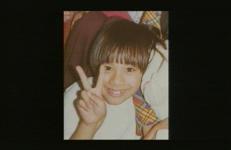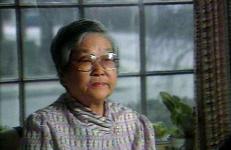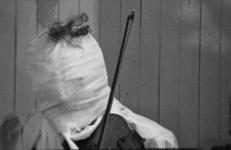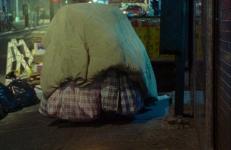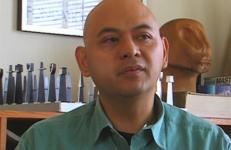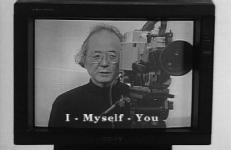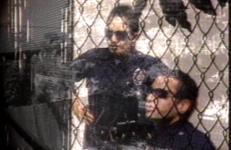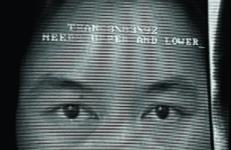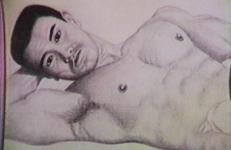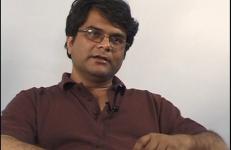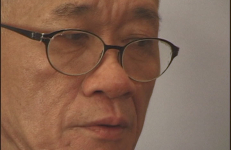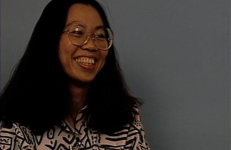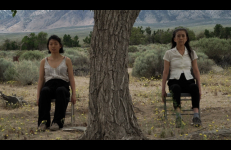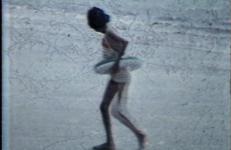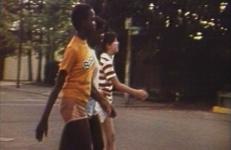Which celebrity do you most resemble? For artist Kip Fulbeck, this question starts a rollicking ride that is part autobiography, part family portrait, part pop-culture survey, and all Disney* all the time. Watch as Fulbeck documents his uncanny resemblance to Pochahontas, Mulan, Aladdin, and other "ethnically ambiguous" animated characters. Both hilarious and touching, this educating video examines the muting of race in mainstream media and its effects on multiracial Americans. *Disney is a registered trademark of Disney Enterprises, Inc.
Asian-American
This title is only available on Kip Fulbeck Selected Videos: Volume One.
My Mother’s Place is an experimental documentary focusing on the artist’s mother, a third-generation Chinese-Trinidadian who at 80 still has vivid memories of a history lost or quickly disappearing. She conveys these with a storytelling style and a frankness that is distinctly West Indian. A tape about memory, oral history, and autobiography, My Mother’s Place interweaves interviews, personal narrative, home movies, and verité footage of the Caribbean to explore the formation of race, class, and gender under colonialism.
This is not a sight-seeing film, but a poetic journey through light and darkness reflected on the city of New York, where I often found empty spaces and times like Ma in Japanese. You do not often see the people walking on the streets or in the buildings, but you may feel the air and the light coming and going. It's not a deserted city, but a city full of energy that is there even without the people. You see the wind is blowing as the bubbles are floating over Wall Street, then up, up to the sky. The Sun sets under the Washington Bridge, where all the cars are runnin
Chance observations of New York's Chinatown, commissioned by the Museum of Chinese in the Americas.
"A sleepwalker's circumnavigation of one of the less homogenized parts of the city."
--Jem Cohen
From childhood memories to recurring nightmares, Nine Fish attacks and illuminates the indecision and confusion surrounding euthanasia and care of the elderly in the United States. In this deeply spiritual and personal video, director Kip Fulbeck chronicles his Cantonese grandmother's physical decline and its continuing impact on his family. The shifting complexities of personal identity, family communication, and cultural assimilation are explored through nine semi-fictional stories.
The popular images of Asian American males, historically propagated in the mass media, range from "silent, sex-less, obedient houseboy" to "mystic martial arts master". Invisibility has been a core element in the public’s perceptions, and is reflected in the one-dimensional representation of Asian men. This is a program by and about Asian-American men. Through their experiences and voices we become privy to the peculiar and insidious ways in which racism affects their evolving self-identities.
This video trilogy of Camera, Monitor, Frame, Observer / Observed, and Observer / Observed / Observer creates a semiology of video as a work on video rather than a written text. Its main purpose is to study the structural relationships between video and language, in this case using the English language. I designed a system depicting the relationship between the observer and the person being observed using words such as "I" and "YOU" through a video feedback system as the basis. This trilogy is a remake of my 1975-76 piece. It is shorter in
This video highlights several narratives concerning video surveillance—not to reiterate the conventional privacy argument but rather to engage the desire to watch surveillance materials and society’s insatiable voyeurism. A variety of subjects recount their interactions with surveillance—getting caught in the act of stealing or watching pornography, being discouraged from making an illegal ATM withdrawal—and question technological determinism, asking whether we choose to develop technology or technology shapes our choices.
The artist visits with seven cosmetic surgeons specializing in blepharoplasty (cosmetic eyelid creasing surgery) in the West Hollywood/Beverly Hills area for initial consultation sessions. The doctors demonstrate different reshaping options and comment upon the prevalence and success rates for different Asian nationalities while Tran presents statistics and facts in text that frame the consultations.
This title is also available on Tran, T. Kim-Trang: The Blindness Series.
In response to the dominant impression that gay people are white people, Orientations aims to set the record straight on homosexual identity. More than a dozen men and women of different Asian backgrounds speak frankly, humorously, and often poignantly about their lives as members of a minority within a minority. They speak about coming out, homophobia, racism, cultural identity, sex, and the ways that being gay and Asian have shaped who they are.
This compilation is produced with "myself" as the sole object, as well as the material of the performance (except two videos with Akiko iimura). The videos are not just documents of the performances, but works of video-art made specifically for utilizing the video system, including the camera and monitor, as part of the performances. The collection also questions the identity of oneself in video, having tense relationships between words and images, and asks who is "I" and what "I" means.
DVD includes:
Self Identity, 1972, 1:00 excerpted
In this interview, Indian artist Shuddhabrata Sengupta (b. 1968) discusses his role in the initiation of the Raqs Media Collective, a Delhi-based artist collective, active since the 1990s. At the time of this interview, Raqs had been creating documentaries, art installations, and educational programs for eighteen years. Sengupta likens the driving force of Raqs to that of a game of catch, a process generated by a back-and-forth dialogue mobilized through writing and in-person meetings. As children of the late sixties, Sengupta explains how and why the members of Raqs, (himself, Jeebesh Bagchi and Monica Narula) share an interest in investigating mass communication, technologies of visibility, and the significance of memory and travel. It is also for this reason, Sengjupta explains, that the Collective’s work is committed to fostering rigorous research in addition to art-making endeavors.
Award-winning videomaker Kip Fulbeck brings his blistering pace, comedic skill, and critical eye to bear on the Hapa and Asian American male experience—parodying the relationships between sex, love, and martial arts movies.
Fulbeck force-feeds the viewer scores of all-too-familiar Asian female/Caucasian male pairings in Hollywood films, and combines them with contemporary excerpts from best-selling novels, magazines, and dating services. Some Questions For 28 Kisses delves into the causes and purposes of these created images and their relation to interracial dating, ethnic fetishes, race and gender wars, and Hapa identity.
“Leads the viewer on a delightfully rip-roaring jaunt through the Asian Pacific American psyche.”
-- Gerard Lim, Asian Week
Ever listen to Loveline? Well, here's an episode with a 24-year-old Korean American guy who's never been kissed. They're offering free concert tickets to any girl who'll come in and take a chance. The girls get their tickets, and "David" gets to pick one of them for his first smack. Trouble is... no volunteers. Combining personal dating stories and the hypnotic imagery of multi-colored koi, Sweet Or Spicy? explores Hapa and Asian American male sexuality in popular culture.
Recently I found myself rising from a forced landing on the floor after being catapulted into the air by an exercise machine and bouncing off the dresser. Through raccoon eyes, the effect of falling on my face, I squinted into the fog-filled room of my present, stumbling about apprehensively, my long-term memory scrambled and short-term memory severely inhibited. My once reliable body and memory were teetering on the brink of self-betrayal.
At the age of twenty-four, Taiwanese artist Tehching Hsieh (b.1950), moved to New York, where he has created and documented time-specific, conceptual art performances since the 1970s. In this interview, Hsieh discusses his formative years and philosophical moorings. This dialogue includes description of the artist’s early period of painting, his military service in Taiwan, and the cultural atmosphere of a country then undergoing massive political change. Much of the discussion focuses specifically on Hsieh’s understanding of the relationship of art and life, his investment in “free thinking,” and the politics of documentation. For Hsieh, the ability to think freely is art’s bottom line—he believes the essence of his work lies in human communication. To this end, Hsieh insists that his work, though incredibly personal, is not autobiographical, but philosophical.
Originally trained as a musical composer, receiving her MFA and Ph.D. from the University of Illinois, Champaign-Urbana, Trinh T. Minh-ha (b. 1952) is a world-renowned documentary feminist filmmaker and expert on avant-garde and third world post-colonial film theory. In 1970, Minh-ha came to the United States from Vietnam at the age of seventeen. Since then she has been involved in film, musical composition, social theory, and critical writing.
On April 30, 2019, Eiko and Alexis Moh, one of Eiko's collaborators in The Duet Project, visited the Manzanar Historical Site. Manzanar was one of ten American internment camps where over 110,000 Japanese Americans were incarcerated during the World War II. At the peak (in September 1942), 10,046 Japanese Americans were forced to live in Manzanar.
This video was shot two days after Manzanar Pilgrimage commemorated its 50th anniversary on site.
A multiple award winner, this experimental tape explores the psychological ramifications of a woman growing up under orthodox Islamic law. Resisting traditional definitions of a woman’s role in society as first and foremost a dutiful daughter or wife, Nanji struggles to find a space amidst the web of restrictive familial and societal conventions.
In the fall of 1986, Richard Fung made his first visit to his father’s birthplace, a village in southern Guangdong, China. This experimental documentary examines the way children of immigrants relate to the land of their parents, and focuses on the ongoing subjective construction of history and memory. The Way to My Father's Village juxtaposes the son’s search for his own historical roots, and his father’s avoidance of his cultural heritage.
Women with a Past brings together four 20th Century artists — Yvonne Rainer, Christine Choy, Martha Rosler, and Nancy Spero — in videotaped interviews, shaped and edited by Lyn Blumenthal to examine the art of documentary. In a skillfully woven series of scenes in which the interviewer’s voice is not heard, the interviewees appear to be talking directly, intimately to the viewer. Blumenthal used short segments of each woman’s work to demonstrate how her philosophical and political stances are articulated.




